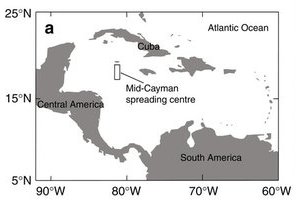The Mid-Cayman spreading centre is a submanene ridge in the middle
of the Caribbean Sea.
Because of its extreme depth scientists are studing the effects of pressure
on hydrothermal venting and the biogeogrphy
of vent fauna.
The depth of the spreading axis of the Mid-Cayman spreading centre,
(MCSC) ranges from 4,200 to >6,000 m,
which makes it the world's deepest seafloor spreading centre. Discovery
works fast those days. The previous record
was the Ashadze-1
vent area in the Atlantic Ocean at 4.080m.
As pressure of the overlying water column influences
the maximum temperature at which hydrothermal fluids can vent at the
seafloor, hydrothermal vent fields on the axis
of the MCSC could exhibit exceptionally high temperatures, producing
vent fluids with unusual physical and chemical
properties.
 (c)
High-temperature venting at the BVF, depth 4,960 m.
(c)
High-temperature venting at the BVF, depth 4,960 m.
(d) Diffuser structures ornamenting sulphide chimneys at the BVF.
|
Two main vents have recently (2010) been surveyed. The Von Damm Vent
Field (VDVF) which is located at a depth
of 2.300?m. The other one is much deeper, the Beebe Vent Field (BVF)
at 4.960?m, which emits copper-enriched
fluidsand - and a buoyant plumethat rises 1.100?m, consistent with >400?°C
venting from what is at present known as
the world's deepest hydrothermal system.
The VDVF is located on upper slopes of the Mount Dent OCC, at a distance
of 13 km to the west of the neovolcanic
zone that defines the active spreading axis of the MCSC. The vent field
consists of a conical sulphide mound, 100 m in diameter and 30 m high
, venting predominantly clear fluids from orifices at its peak
 (a)
Peak of sulphide edifice at the VDVF, depth 2,300 m, covered by
an aggregation
(a)
Peak of sulphide edifice at the VDVF, depth 2,300 m, covered by
an aggregation
of alvinocaridid shrimp. (b) Clear vent fluids and alvinocaridid
shrimp at the VDVF. |
Located at a depth of 4,960 m on the neovolcanic axis of the MCSC,
the BVF lies 880 m deeper than the previous
deepest known vent field at Ashadze-1 on the Mid-Atlantic Ridge. The
BVF consists of a sulphide mound 80 m
in diameter and 50 m high (see above:d), surmounted with several actively
venting sulphide chimneys . An area of
weathered sulphide rubble extends for a further 800 m to the east of
the active mound.
The hydrothermal plume from the BVF rises ~1,100 m into the water column.
This contrasts with other vent fields,
where buoyant plumes typically only rise 200–400 m into the water
column.
 (a)
Aggregation of alvinocaridid shrimp on an active chimney at the
BVF. (b) Anemones and microbial mats at the BVF. (c) Aggregation
of dead mussel shells on the Mount Dent OCC.
(a)
Aggregation of alvinocaridid shrimp on an active chimney at the
BVF. (b) Anemones and microbial mats at the BVF. (c) Aggregation
of dead mussel shells on the Mount Dent OCC.
(d) Empty tubes resembling those of siboglinid polychaetes on
the Mount Dent OCC. |
Connelly, D. P. et al. Hydrothermal
vent fields and chemosynthetic biota on the world's deepest seafloor spreading
centre.
Nat. Commun. 3:620 doi: 10.1038/ncomms1636 (2012).
http://www.nature.com/ncomms/journal/v3/n1/full/ncomms163 6.html
|





